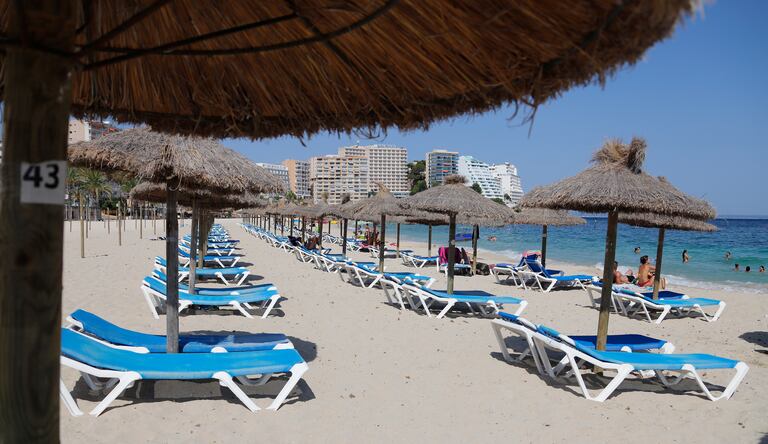Sun lounger area on the beach of Magaluf, in Mallorca, almost empty on July 30.CLARA MARGAIS / Getty Images
The coronavirus has left tourism on the brink.
Spring was completely lost, with confinements and restrictions on mobility.
The sector seized on the summer as a lifeline, but in reality it has been the last straw.
The July data are dire in the main tourist areas, with great dependence on foreign travelers.
And August has been even worse, according to the data handled by the sector.
So much so that they have advanced the closure in destinations such as the Balearic Islands and Benidorm.
The other side of the coin has been lived on the north coast of the country, Cádiz or Huelva, where they have withstood the blow better.
This 2020 will go down in history as the worst exercise in Spanish tourism.
The forecast already points to a hole of almost 100,000 million in the year as a whole, according to Exceltur, with unprecedented collapses in sun and beach destinations and large cities.
The board has turned upside down and the data throws some exceptions where the blow has been cushioned.
This does not mean that they will end a good year.
Not even tie.
But in view of what we have seen, ending a loss of travelers below 40% is a success.
Among the best unemployed are Asturias (only a 23.5% drop in travelers in July), Cantabria (-27.2%), Jaén (-33.2%), Huelva (-35%) and Cádiz, Gipuzkoa and Huesca (-36%), according to the National Institute of Statistics (INE).
If you look at the overnight stays, some of the previous ones are repeated among those that have best weathered the storm, to which are added inland destinations.
Asturias is once again the best (24.2% of overnight stays less than a year before).
It is followed by Guadalajara (-32.4%) and Soria, Cantabria and Ávila (-34%).
"The areas that depend more on Spanish demand have registered a good occupation, enough to defend themselves at least", argues José Luis Zoreda, vice president of Exceltur.
Although with many nuances, even within the same area.
“In Andalusia, Cádiz and Huelva have defended themselves.
But the Costa del Sol (Malaga) has sunk because it depends on foreign tourism ”, he explains.
Thus, the bitter side of the summer season covers almost the entire map.
The situation is bleak in destinations such as the Balearic Islands, which lost 80.4% of travelers in July and 84.2% of overnight stays.
In line with the falls of Barcelona, Madrid and, a little less, the Canary Islands.
"During the de-escalation, the bet was national tourism, but it was evident that it would not be enough to make up for the lack of foreign travelers," says Juan Ignacio Pulido, professor of Applied Economics at the University of Jaén.
With these July data, which show improvements compared to June —the country was in a de-escalation phase and with the borders closed until June 21—, the most optimistic could expect a better August to fix part of the damage.
But nothing could be further from the truth, especially due to the string of restrictions that have been imposed on travel.
Especially from the United Kingdom, which arrived at the end of July, for being the first to re-impose quarantine and for being the largest fishing ground for foreign travelers.
"The incipient recovery that foreign tourism had shown in Spain at the end of June and the beginning of July seems to have been truncated in August," the Bank of Spain collects in a recent report.
And send a warning to sailors: recovery will take time to come.
"According to the most recent scenarios from the World Tourism Organization, it is unlikely that global tourism flows will reach pre-health crisis levels before 2022."
That is, there is at least another year left in the desert.
All the major organizations in the tourism sector, as well as government sources, agree that this summer there are few winners and many losers.
“We have all lost, including the country.
The balance of the season is very negative, despite the positive results in the north of the country or inland areas.
The sun and beach segment, which is the most important, has had a very bad season ”, argues Jorge Marichal, president of the Spanish Confederation of Hotels and Tourist Accommodation.
An example of the low demand is the operational hotel capacity.
On the islands, for example, the blind was lowered in more than 60% of the establishments in July, according to the INE.
And hotel companies admit that August has been even worse.
However, in Cádiz, Huelva, Asturias, Pontevedra, Gipuzkoa and Cantabria around 90% of the hotels opened.
And they recorded an occupancy by places of around 50%.
A complete success if compared with 35% of the national average (half that in 2019), a very poor figure, even more so since only half of the existing places are open.
"All this has been reflected in the rates, with price reductions and offers to try to attract customers and that undecided demand," explains Marichal.
But this aggressive pricing policy has not been enough to offset an unprecedented slump in demand.
The problem is not in the supply, it is that there are no tourists due to the health crisis.
"This dynamic of deterioration is causing the closure of a certain proportion of hotel establishments before the end of the season (...) and a further worsening of the outlook," adds the Bank of Spain.
More generous aid
In this situation, public policies to help a drowned sector gain even more importance.
Especially the ERTE, in full negotiation for its extension until the end of January.
The Government's intention is to focus them on sectors such as tourism, although there are notable differences with the social agents.
Tourism is the economic activity that is pulling the mechanism the most: "Of the 812,438 employees who remained under ERTE at the end of August, 40% belong to the tourism sector, specifically 325,578 people," he detailed last week in Congress Fernando Valdés, Secretary of State for Tourism.
Tourism organizations press for an extension by sectors, which would give them a greater breath of air by having more generous exemptions in Social Security contributions.
“For the first time in history the great engine of the Spanish economy has seized.
That is why we need significant help and differential treatment to survive ”, defends Zoreda.
Something that Marichal insists on, adding: "Tens of thousands of jobs are at risk."
Administration sources insist that, according to the data they handle by region, if a more generous aid is not approved, many companies in the tourism sector will not be able to hold out and will go from ERTE to ERE.
Juan Ignacio Pulido agrees in this analysis, since he considers that the files have been the support of employment so far.
Although a future with many clouds is planned: “ERTE cannot be indefinite and it remains to be seen how long it can be maintained.
But it is clear that without this it would be unsustainable.
Even with the extension, depending on the bonuses, there will be companies that will close down ”, he concludes.
Information about the coronavirus
- Here you can follow the last hour on the evolution of the pandemic
- This is how the coronavirus curve evolves in Spain and in each autonomy
- Questions and answers about the coronavirus
- Guide to action against the disease
- In case of having symptoms, these are the telephones that have been enabled in each community
- Click here to subscribe to the daily newsletter on the pandemic









